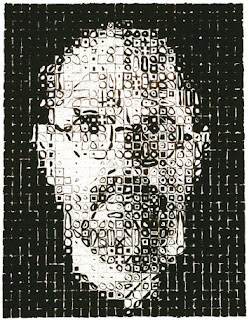I saw "Picasso and Braque Go to the Movies." I am not convinced by its thesis, that cinematic structures deeply influenced the artists and led to Cubism. But I did enjoy hearing the opinions of some of the artists and critics, particularly Chuck Close. He says that he loves the idea that "the color has just been sucked out of" Cubist work. In his own paintings, Close says, "I just didn't want to depend on color ... to carry the painting." And some of Close's black and white works read a bit like holding an old black and white home-movie canister and reeling the film out between your hands. Close works from photographs, copied onto a grid on canvas; here is a self-portrait from 1991:
It is a powerful piece; when you see Close's work in a gallery, often the works are so large that you need to step back as far as possible to allow the work to complete itself. And this push-pull of the work is quite deliberate, as Close goes on to tell us (in the movie's interview). Close says he feels at home with "the extreme artificiality of Cubism. It was not about space. It was not about atmosphere. It was not about the way we see things in nature. [I disagree with this, but we'll get to that another time!]. It's highly compressed, intensely flat; you are always aware that you are looking at the distribution of colored dirt on a flat surface ... it is as artificial as it is real. It's the tension between the artificiality and the reality that makes the difference .... it's like you're watching ... [the painting] happen in front of your very eyes."
So let's do that, with a piece in color: "Maggie," from 1996:
Now look at a close-up of her eye:
Here we have the artificiality, the beauty, the pattern ... it's amazing the way Close manages both aspects, the real and the artifice, in each of his works.
I was reading Brian Edmonds' blog (and saw a video on Karel Appel from 1961 -- still fierce) and he suggested the names of a few Bay Area painters -- people I did not know. I found myself really liking one artist, Elmer Bischoff, who also played with black and white, and color, and then abstraction, the figuration, before a final return to abstraction. I am pretty interested in this, since I am playing with both figuative and abstract work myself. Bischoff said that returning at the end of his life to abstraction was like "leaving a church and entering a gymnasium." Here is an early figurative drawing (also sometimes called a painting, although it also looks like a monotype-- not on view right now, but owned by SFMOMA); it is called "Girl Looking in Mirror":
Bischoff said that his only demand of his work was that it be "potent." This is, for me, powerful, mysterious, a bit of Rembrandt, almost Caravaggio -- look at all those sources of light! But it is also a kind of dark piece, I think, and a real contrast to this late work, "Untitled # 78" (1984):
This painting seems to me to be exactly what Bischoff said, a bit like entering an unlimited space; it feels a relief. The tension is still there, for me, in the play between these apparent abstract spaces and their worldly counterparts (are those layers? is that a chasm in a rock? are those folds in material? no, of course not, and yet, if we could just get far enough away....). He isn't so much depending on color, here, as he is not depending on light and shadow. And all this -- from both Close and Bischoff -- on a two-dimensional static surface.





No comments:
Post a Comment